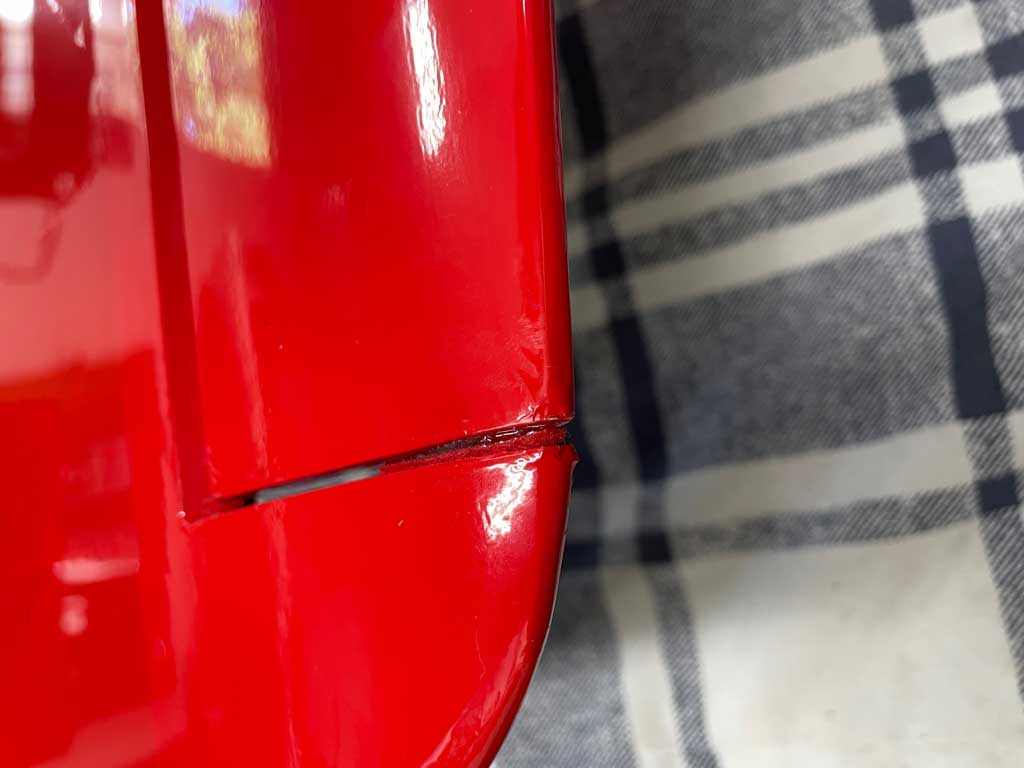Q. The aileron (or rudder or elevator) of my model is buzzing like crazy. It's going back and forth so fast it's nearly a blur. What's wrong?
A. Yup, seen it before. Happens to any servo, any brand. Usually it's because of the control surface being so large it flexes (you only think it's rigid, it's not, not really). Bet you a milkshake what you're seeing looks like this, right?
- Extreme Flight elevator experiences positive feedback oscillations
The fix is in
Fortunately, there's an easy fix . . . use a bit of Velcro (the fuzzy side) like in this hero image for this post. No, you don't have to get fancy and color coordinate in red Velcro (but it does look nicer because it kind of disappears).

- A bit of fuzzy Velcro provides a slight bit of drag to damp oscillations.
What's really happening?
Anyway, what you're experiencing isn't to do with the servo - but - is 100% with the control surface not being as rigid as you might think. Basically, everything is a spring, even an anvil. What's more, I'll bet a milkshake if you disconnect the linkage, the servo doesn't do it any longer. Point being, a little bit of drag at neutral keeps it from ever really getting going.
And to repeat, it happens mostly with large flexible control surfaces of a type usually seen on 3D models, even small models - ones as small as 48" but ranging up to and including 35% and 42% models.
Why 3D models? These especially because the control surfaces are so large and lightly built. An elevator control surface, for example, may be as much as 60% of the entire horizontal surface area! And not only is it huge but it's definitely not as stiff as you may suppose because of the never ending quest of air frames that weigh nothing at all.
It only seems rigid
Point being, while the control surface feels like it's rigid, it's not really, not in the grand scheme of things it's not. Meaning, when it flexes and returns to neutral (springs back to shape, actually) this mechanical motion bumps the pot (potentiometer), which nudges it out of position and the servo electronics sense this as unwanted movement and thus, command a return to center. And this command is issued quickly - with our servos on the order of 350 times per second (350Hz) but even slower servos with refresh cycles of 125 or 250Hz, they're apt to do this. So it's not due to a defect in the servo. Physics.
Anyway, this all happens so fast the control surface flexes again (like a Disney cartoon character rebounding in slow motion), and when it springs back into shape, this once again bumps the pot, which starts the cycle allover again. Rinse, repeat!
Whats's more, this may happen with any and all brands of servos . . . and it's not a defect.
What is it? It's mechanical feedback caused by the springy-ness of the control surface feeding back into the potentiometer. In short, what you're seeing is referred to as a positive feedback oscillation. By the way, positive feedback takes a system away from the state of stability, while negative feedback gives a system more stability. What's more, we see this electronically too.
An example you may be more familiar with are oscillations induced by gain, e.g. with gyroscopes. The positive feedback occurs when running the gain too high, and thus, lowering the gain stops it.
In the case of a mechanical oscillation, adding a little bit of drag using the fuzzy side of a piece of Velcro is the mechanical equivalent of lowering the gain on a gyro. It adds 'just' enough drag to preclude the oscillation from ever getting going. here's the same model after the Velcro trick.
- Fuzzy Velcro stops Extreme Flight elevator positive feedback oscillations
Wrapping this up
Anyway, and quite honestly, it's our view we're quite fortunate this little bit of mechanical damping works because it removes the stress of not know what's going on with our model airplane. And believe me, we get it how this can be stressful the first time you encounter it. We know from first hand experienced. About had a heart attack thinking there was something wrong with the servo due to the incessant nattering of the surface.
So the magic of what the fuzzy side of a piece of Velcro provides is a slight bit of drag, a mechanical change in feedback. This makes it stop. You could 'lightly' touch the control surface with your fingertip and achieve the same thing, but Velcro is easier.
Note; ours aren't the only ones, watch these videos of other brands discussing this same thing.
ProTip; this doesn't happen in the air because the forces of air flowing over the control surfaces keep it from ever beginning. Meaning this is strictly a static event. Point being, it's nothing to fret overly much about because it's entirely due to the size of the control surfaces. So while this was unheard of back in the days when a large elevator was 1-1/2" wide, today, control surfaces 6-1/2" or even 8-10" wide are not all that unusual.
Since we know it bothers you we've shown you how to stop it from happening using a bit of inexpensive Velcro. Just adding a bit of damping via the popular Velcro dot trick is sure to leave you feeling better. Try it, it works!
One last tip. The drag doesn't need to be added at the control surface. For example, a model using pushrods to control the surface are sorted with a bit of drag within the fuselage (perhaps where the pushrod nears a former. Works this way also . . . easy peasy!
--
John